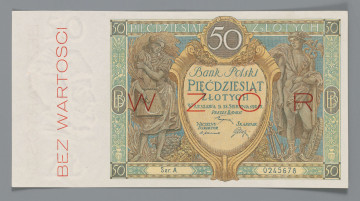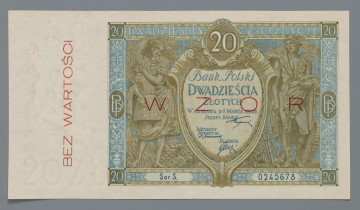
Cheque for 50,000,000 Polish marks - a template
1923
National Museum in Lublin
Part of the collection: Paper money during the Second Polish Republic
Polish banknotes issued after 1930 were not part of a single series. The individual denominations differed both stylistically and graphically. In 1936 the Bank of Poland decided to abandon this practice. At the same time, it was decided to change the production process to make the banknotes more attractive and durable. Wacław Borowski was entrusted with the design of the new banknotes. Like many Polish painters and graphic artists of the interwar period, he studied at the Kraków Academy of Fine Arts, where he was Józef Mehoffer’s disciple, among others. The series of banknotes he designed was to include denominations from 10 to 500 zlotys, the common element being the commemoration of distinguished Polish commanders. Unfortunately, the outbreak of war prevented the project from being fully realised. Before the outbreak of the war, only the 20-zloty banknote was put into official circulation.
Among other banknotes of the series, the fifty-zloty banknote with the image of General Jan Henryk Dąbrowski was also put into production. By the outbreak of the Second World War, only a small part of the designed print run had been produced. In unknown circumstances, several copies were circulated in the first days of September 1939 in the Pomeranian Voivodeship.
The 20-zloty banknote features the image of Emilia Plater, the heroine of the November Uprising. Her portrait was placed on the obverse and in the form of a watermark in the banknote's margin. The twenty-zloty coin went into circulation on 30 September 1938 and remained in circulation also in the first months of the occupation. The authorities of the General Government set the date for its withdrawal from circulation as 7 May 1940, but it was finally withdrawn on 31 May of that year. In a sense, the life of this banknote was longer. It became a pattern for an occupational banknote of the same denomination, issued by the Emission Bank in Poland, an institution established for the territory of the General Government by the German occupation authorities. Both banknotes were almost identical as far as their design was concerned. The only difference was the portrait of the Białowieża forester in the unprinted margin of the new banknote, where the watermark was on the pre-war banknotes.
Leszek Poniewozik
Author / creator
Dimensions
cały obiekt: height: 164 mm, width: 87 mm
Object type
paper money
Technique
Material
paper
Creation time / dating
Creation / finding place
Owner
The National Museum in Lublin
Identification number
Location / status

1923
National Museum in Lublin

1925
National Museum in Lublin

1926
National Museum in Lublin
DISCOVER this TOPIC
Museum of King Jan III's Palace at Wilanów
DISCOVER this PATH
Educational path